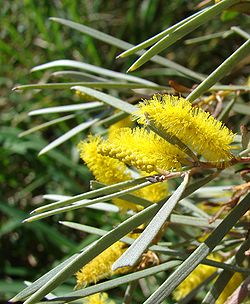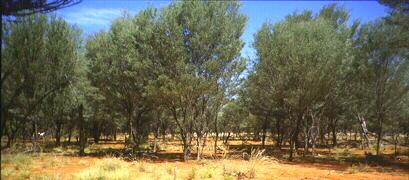Difference between revisions of "Acacia aneura"
| Line 1: | Line 1: | ||
{{SPlantbox | {{SPlantbox | ||
|familia=Fabaceae | |familia=Fabaceae | ||
| − | |genus=Acacia | + | |genus=Acacia |
| − | |species=aneura | + | |species=aneura |
|common_name=Mulga | |common_name=Mulga | ||
|name_ref=Flora - A Gardener's Encyclopedia | |name_ref=Flora - A Gardener's Encyclopedia | ||
| Line 19: | Line 19: | ||
|exposure=sun | |exposure=sun | ||
|sun_ref=Flora - A Gardener's Encyclopedia | |sun_ref=Flora - A Gardener's Encyclopedia | ||
| − | |features=flowers | + | |features=flowers, bees |
|flower_season=early spring, mid spring, late spring, early winter, mid winter, late winter | |flower_season=early spring, mid spring, late spring, early winter, mid winter, late winter | ||
|flower_ref=Flora - A Gardener's Encyclopedia | |flower_ref=Flora - A Gardener's Encyclopedia | ||
| Line 27: | Line 27: | ||
|usda_ref=Flora - A Gardener's Encyclopedia | |usda_ref=Flora - A Gardener's Encyclopedia | ||
|max_zone=10 | |max_zone=10 | ||
| − | |image= | + | |image=Acacia aneura blossom.jpg |
| − | + | |image_width=200 | |
| − | |||
| − | |||
| − | |||
| − | |||
| − | |||
| − | |||
| − | |||
| − | |||
| − | |||
| − | |||
| − | |||
| − | |||
| − | |||
| − | |||
| − | |||
| − | |||
| − | |||
| − | |||
| − | |||
| − | | image_width = | ||
| − | |||
| − | |||
| − | |||
| − | |||
| − | |||
| − | |||
| − | |||
| − | |||
| − | |||
| − | |||
}} | }} | ||
| + | '''''Acacia aneura''''', commonly known as '''[[Mulga]]''' or '''True Mulga''', is a shrub or small tree native to arid [[outback]] [[Australia]] of areas such as the [[Western Australian Mulga shrublands]]. | ||
| + | |||
| + | Mulga is highly variable, in form, in height, and in shape of phyllodes and seed pods. It can form dense [[forest]] up to 15 metres high, or small, almost heath-like low shrubs spread well apart. Most commonly, it is a tall shrub. Because it is so variable, the [[taxonomy]] of the Mulga has been studied extensively, and although it is likely to be split into several species eventually, there is as yet no consensus on how or even if this should be done. Although generally small in size, Mulga is long-lived, a typical [[life expectancy|life span]] for a tree undisturbed by fire is in the order of 200 to 300 years. | ||
| + | |||
| + | Mulga has developed extensive adaptations to the Australian [[desert]]. Like many ''[[Acacia]]'' species, Mulga has thick-skinned [[phyllode]]s. These are optimised for low water loss, with a high oil content, sunken [[stomata]], and a profusion of tiny hairs to reduce [[transpiration]]. During dry periods, a Mulga drops much of its foliage to the ground, which provides an extra layer of [[mulch]] and from where the nutrients can be recycled. | ||
| + | |||
| + | Like most Australian '''Acacia''' species, mulga is thornless.<ref>[http://www.aridzonetrees.com/AZT%20Interactive%20Buttons/Tree%20Index/Cut%20sheets/Acacia/Acacia%20aneura.htm Arid Zone Trees]</ref> The needle-like phyllodes stand erect to avoid as much of the midday sun as possible and capture the cooler morning and evening light. Any rain that falls is channeled down the phyllodes and branches to be collected in the [[soil]] immediately next to the trunk, providing the tree with a more than threefold increase in effective rainfall. Mulga roots penetrate far into the soil to find deep moisture. The roots also harbour [[bacteria]] that [[nitrogen fixation|fix]] atmospheric [[nitrogen]] and thus help deal with the very old, nutrient poor soils the species grows in. | ||
| + | |||
{{Inc| | {{Inc| | ||
| − | + | Acacia aneura, F. v. M. Mulga. A shrub with terete branches lined with gum along the longitudinal fissures: phyll. rigid, with oblique point, varying from lanceolate-falcate to long-linear or almost terete on the same plant, 1-3 in. long, 1/24in. wide; no prominent nerves, but distinctly striate under a lens: fls. in spikes (which may be single or in pairs), 1/2-3/4in. long, 5-merous; calyx narrow spatulate, not half so long as petals; peduncles less than 1/4in. long: pods flat, oblique, with a narrow wing at suture and recurved point at apex, 1-1 1/2 in. long, nearly 1/2in. wide; seeds nearly transverse, marked by a minute horseshoe; funicle not encircling seed but with 2 or 3 short thick folds | |
| − | Acacia aneura, F. v. M. Mulga. A shrub with terete branches lined with gum along the longitudinal fissures: phyll. rigid, with oblique point, varying from lanceolate-falcate to long-linear or almost terete on the same plant, 1-3 in. long, 1/24in. wide; no prominent nerves, but distinctly striate under a lens: fls. in spikes (which may be single or in pairs), 1/2-3/4in. long, 5-merous; calyx narrow spatulate, not half so long as petals; peduncles less than 1/4in. long: pods flat, oblique, with a narrow wing at suture and recurved point at apex, 1-1 1/2 in. long, nearly 1/2in. wide; seeds nearly transverse, marked by a minute horseshoe; funicle not encircling seed but with 2 or 3 short thick folds | ||
{{SCH}} | {{SCH}} | ||
}} | }} | ||
==Cultivation== | ==Cultivation== | ||
| − | + | ||
===Propagation=== | ===Propagation=== | ||
| − | + | ||
===Pests and diseases=== | ===Pests and diseases=== | ||
| − | |||
| − | == | + | |
| − | + | ==Varieties== | |
| + | There are a number of recognised varieties: | ||
| + | * [[Acacia aneura var. aneura|''A. a.'' var. ''aneura'']] | ||
| + | * [[Acacia aneura var. argentea|''A. a.'' var. ''argentea'']] | ||
| + | * [[Acacia aneura var. fuliginea|''A. a.'' var. ''fuliginea'']] | ||
| + | * [[Acacia aneura var. intermedia|''A. a.'' var. ''intermedia'']] | ||
| + | * [[Acacia aneura var. macrocarpa|''A. a.'' var. ''macrocarpa'']] | ||
| + | * [[Acacia aneura var. major|''A. a.'' var. ''major'']] | ||
| + | * [[Acacia aneura var. microcarpa|''A. a.'' var. ''microcarpa'']] | ||
| + | * [[Acacia aneura var. pilbarana|''A. a.'' var. ''pilbarana'']] | ||
| + | * [[Acacia aneura var. tenuis|''A. a.'' var. ''tenuis'']] | ||
==Gallery== | ==Gallery== | ||
| − | + | <gallery perrow=5> | |
| − | + | File:Mulga.jpg|Mulga woodland. The tallest trees in this photograph are approximately 7 [[meter|m]]. | |
| − | |||
Image:Upload.png| photo 1 | Image:Upload.png| photo 1 | ||
Image:Upload.png| photo 2 | Image:Upload.png| photo 2 | ||
| Line 88: | Line 73: | ||
==References== | ==References== | ||
| − | + | <references/> | |
<!--- xxxxx *Flora: The Gardener's Bible, by Sean Hogan. Global Book Publishing, 2003. ISBN 0881925381 --> | <!--- xxxxx *Flora: The Gardener's Bible, by Sean Hogan. Global Book Publishing, 2003. ISBN 0881925381 --> | ||
<!--- xxxxx *American Horticultural Society: A-Z Encyclopedia of Garden Plants, by Christopher Brickell, Judith D. Zuk. 1996. ISBN 0789419432 --> | <!--- xxxxx *American Horticultural Society: A-Z Encyclopedia of Garden Plants, by Christopher Brickell, Judith D. Zuk. 1996. ISBN 0789419432 --> | ||
| Line 97: | Line 82: | ||
{{stub}} | {{stub}} | ||
| − | + | __NOTOC__ | |
| − | |||
| − | |||
Latest revision as of 00:43, 2 July 2010
| Habit | tree
| |
|---|---|---|
| Height: | ⇕ | 10 ft"ft" can not be assigned to a declared number type with value 10. to 30 ft"ft" can not be assigned to a declared number type with value 30. |
| Width: | ⇔ | 12 ft"ft" can not be assigned to a declared number type with value 12. |
| Lifespan: | ⌛ | perennial |
| Bloom: | ❀ | early spring, mid spring, late spring, early winter, mid winter, late winter |
| Exposure: | ☼ | sun |
|---|---|---|
| Features: | ✓ | flowers, bees |
| USDA Zones: | 9 to 10 | |
| Flower features: | ❀ | orange, yellow |
|
Fabaceae > |
Acacia > |
aneura > |
Acacia aneura, commonly known as Mulga or True Mulga, is a shrub or small tree native to arid outback Australia of areas such as the Western Australian Mulga shrublands.
Mulga is highly variable, in form, in height, and in shape of phyllodes and seed pods. It can form dense forest up to 15 metres high, or small, almost heath-like low shrubs spread well apart. Most commonly, it is a tall shrub. Because it is so variable, the taxonomy of the Mulga has been studied extensively, and although it is likely to be split into several species eventually, there is as yet no consensus on how or even if this should be done. Although generally small in size, Mulga is long-lived, a typical life span for a tree undisturbed by fire is in the order of 200 to 300 years.
Mulga has developed extensive adaptations to the Australian desert. Like many Acacia species, Mulga has thick-skinned phyllodes. These are optimised for low water loss, with a high oil content, sunken stomata, and a profusion of tiny hairs to reduce transpiration. During dry periods, a Mulga drops much of its foliage to the ground, which provides an extra layer of mulch and from where the nutrients can be recycled.
Like most Australian Acacia species, mulga is thornless.[1] The needle-like phyllodes stand erect to avoid as much of the midday sun as possible and capture the cooler morning and evening light. Any rain that falls is channeled down the phyllodes and branches to be collected in the soil immediately next to the trunk, providing the tree with a more than threefold increase in effective rainfall. Mulga roots penetrate far into the soil to find deep moisture. The roots also harbour bacteria that fix atmospheric nitrogen and thus help deal with the very old, nutrient poor soils the species grows in.
Read about Acacia aneura in the Standard Cyclopedia of Horticulture
|
|---|
|
Acacia aneura, F. v. M. Mulga. A shrub with terete branches lined with gum along the longitudinal fissures: phyll. rigid, with oblique point, varying from lanceolate-falcate to long-linear or almost terete on the same plant, 1-3 in. long, 1/24in. wide; no prominent nerves, but distinctly striate under a lens: fls. in spikes (which may be single or in pairs), 1/2-3/4in. long, 5-merous; calyx narrow spatulate, not half so long as petals; peduncles less than 1/4in. long: pods flat, oblique, with a narrow wing at suture and recurved point at apex, 1-1 1/2 in. long, nearly 1/2in. wide; seeds nearly transverse, marked by a minute horseshoe; funicle not encircling seed but with 2 or 3 short thick folds CH
|
Cultivation
Propagation
Pests and diseases
Varieties
There are a number of recognised varieties:
- A. a. var. aneura
- A. a. var. argentea
- A. a. var. fuliginea
- A. a. var. intermedia
- A. a. var. macrocarpa
- A. a. var. major
- A. a. var. microcarpa
- A. a. var. pilbarana
- A. a. var. tenuis
Gallery
Mulga woodland. The tallest trees in this photograph are approximately 7 m.
References
External links
- w:Acacia aneura. Some of the material on this page may be from Wikipedia, under the Creative Commons license.
- Acacia aneura QR Code (Size 50, 100, 200, 500)


